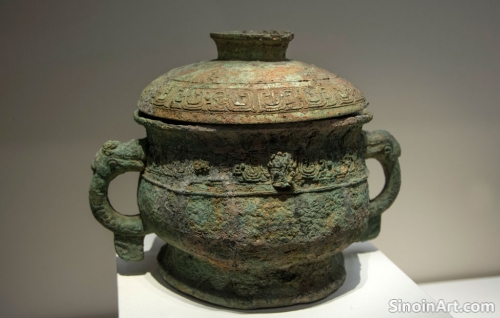Bronze Ware and Ancient Chinese Beliefs About the Afterlife: Providing for the Journey and Eternal Life
|
The inclusion of bronze objects in ancient Chinese tombs reflects a deep-seated belief in the afterlife, with these artifacts intended to equip the deceased for their journey into the world of spirits, and also to help them achieve a lasting form of existence beyond their earthly life. The placement of these objects was often intended to create a seamless transition from the earthly world to the world of the spirits, and these objects were both functional and also highly symbolic.  Bronze ritual vessels were placed in tombs so that they could continue to be used for offerings to ancestors and spirits, sustaining the soul in its new existence. The inclusion of ritual objects from their earthly life helped to establish a sense of continuity and connection to the traditions of the past.  Bronze weapons were often included in tombs to provide protection against evil spirits and also to symbolize the deceased's power and status, even in the afterlife. The belief that the challenges of the earthly world would continue into the afterlife was a driving factor in the selection of the artifacts that were included in the burial process.  Bronze mirrors were often believed to help guide the soul on its journey, and to also offer a glimpse into other worlds, further underscoring the connection between the material world and the spiritual realms. These objects were seen to have a power beyond the everyday world, and they were therefore considered to be important components of a proper burial ritual. The study of bronze ware in burial contexts provides valuable insights into ancient Chinese beliefs about the afterlife, highlighting the desire for continuity, protection, and the belief in an existence that transcended the mortal realm. The study of these practices is a valuable way of understanding their belief systems and their culture. |
Tag : bronze afterlife beliefs, ancient Chinese tombs, funerary practices, spirit journey, eternal life
Related information
- Bronze Ware as Grave Goods: Status, Belief, and the Afterlife
- The Role of Bronze in Ancient Chinese Agriculture: Tools, Irrigation, and Food Production
- The Influence of Ancient Chinese Bronze Ware on Later Japanese Art and Design
- Bronze Ware and Ancient Chinese Astronomy: Celestial Motifs and Interpretations
- Bronze Ware and Ancient Chinese Understanding of Astronomy: Maps of the Sky and the Measurement of Time
This article explores the use of bronze ware as grave goods in ancient China, highlighting its connection to beliefs about the afterlife, the social status reflected in the types and quantities of objects, and how the placement of these objects reveals insights into ritualistic practices.
This article explores the role of bronze in ancient Chinese agriculture, highlighting its use in creating more effective tools, developing irrigation systems, improving food processing, and its contribution to greater agricultural efficiency and economic development.
This article explores the influence of ancient Chinese bronze ware on later Japanese art and design, highlighting the adoption of Chinese forms and techniques, the development of unique Japanese styles, and the impact of cultural exchange on creative expression.
This article explores the connection between bronze ware and ancient Chinese astronomy, highlighting the presence of celestial motifs, the creation of astronomical instruments in bronze, and how this interrelation reveals insights into ancient Chinese worldview and their understanding of the universe.
This article explores the connection between bronze ware and ancient Chinese understandings of astronomy, highlighting the use of celestial motifs, the depiction of astronomical phenomena, and the creation of instruments that aided in understanding the universe.